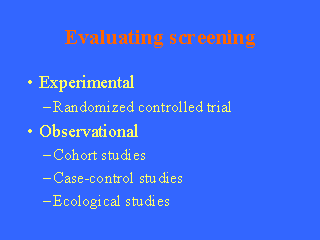 |
All of the usual epidemiological study designs can be applied in the
evaluation of screening. However, the ideal approach is a randomized
trial of screening with mortality from disease as the endpoint. This
approach controls for the screening biases that were just described.
Such trials of screening are difficult to conduct. They require large
numbers of subjects and long periods of follow-up, needing substantial
amounts of resources.
Observational studies of screening are more limited but can often
provide dramatic evidence of the benefits of screening. One commonly
used screening test, the Pap smear for cervical screening, has never
had a randomized trial yet there is convincing evidence of its benefit
from observational studies.
|
